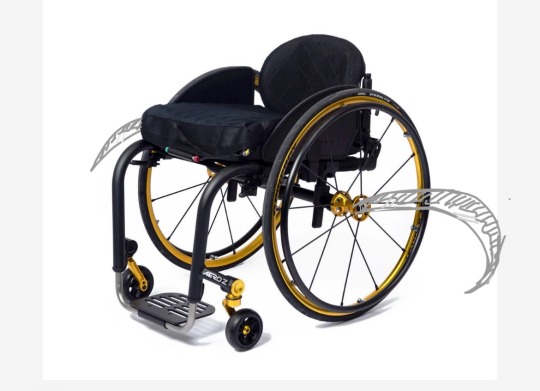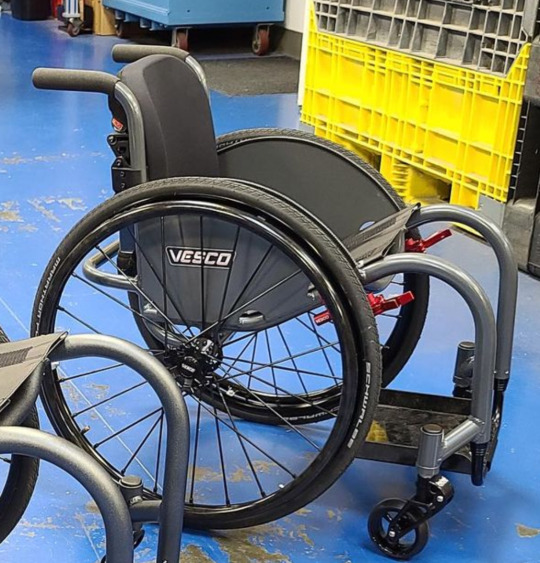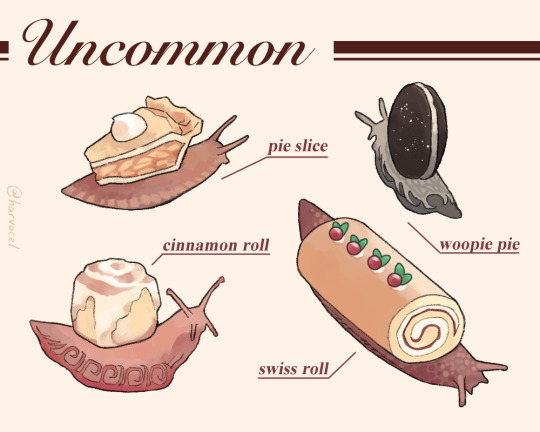Text
so you know those scythed chariots used in ancient times (think at least ancient greek/persian times?)… with blades on wheels to cut through crowds….

[id: drawn picture of two armored men in standing chariot, where at axle of wheels have curved blade sticking out. chariot lead by 2 horses. end id]
consider….

[id: black custom ultralight wheelchair with gold accents. end id]
…

[id: same wheelchair but with similar curved blades drawn on axle of wheels. end id]
(tho apparently those chariots not that effective in battle as you would think but. jk. unless….👀?)
76 notes
·
View notes
Text
saw small custom wheelchair maker company/person post picture of chair where like. back to seat angle near 45 degrees. n am like. “that. that is a LOT of dump😳”

[id: grey/black active wheelchair as describe above. end id]
from instagram vescometalcraft n they look like do cool stuff
#🍞.txt#it most likely for SCI paralysis and/or for some sport or fitness reason but holy shit#there’s a flat part idk word right now but that part probably make big difference compare to one with just straight 45 degree without it#but still omg😳
24 notes
·
View notes
Text




snastries (snail pastries)
5K notes
·
View notes
Text
PCP & me suspect myasynthia gravis re:combo of symptoms that worsen recent couple weeks/1 month & she look into any blood test n hope she as PCP can do them & if do have MG hope have version that show up on blood test. presentation & progression a bit atypical also some parts fit but finger crossed get good news n answers
13 notes
·
View notes
Text
couple more things abt this:
1. every time different usernames and different names/versions of names (from kait to now new blog just “K”), plus keep [honestly maybe even near stalking?] blogs that have her other blogs blocked - she has to have known. it has to be deliberate. she knows what she’s doing.
2. when had some of their blogs blocked but evidently either forgot some or forgot to also block on side blog, one of her account sent this:

[id: tumblr ask sent by username wonky-world, reads “Hi. I know you from Reddit, as one of the mods on spicyautism and i can't help but love your content! It's so informational, keep it up!
I'm just hoping to send some dopamine your way if that helps” end id.]
got this ask while ago & originally was just gonna ignore it leave it but evidently she not stopping, so share this for people safety. sounds innocent & even good without context but with her history especially clear block evasion, unwanted and annoying.
so she is also mod on subreddit SpicyAutism (at least according to one of her blogs), in case you want avoid her but also use that subreddit.
3. “but she/i have changed!”
sure. maybe.
but one way change & recognizing harm is knowing sometimes even though you change, people impacted may not want anything do with you. and that their right. if not able recognize & live with this, you not fully change.
and, on top of that, remake blogs with different usernames & go by different versions of names, to refollow people blocked you, who made clear don’t want you interact - is definition of block evasion. you not changed.
4. for kait: in case you’re following me through yet another blog: you are not welcomed. do not interact with me. don’t want you on my blog. go away. every couple of weeks you / stuff abt you pop up & inevitably need think about you & want drop this already!!!!! want to leave you alone you make it impossible.
think that’s all for now
Still very upset and dysregulated, but wanted to give a heads up for others who used to have this person blocked.
autisticallyalivehuman
Is autistkait/autisticamelia/blacksheepofsociety/all those other usernames they had. If Kait is someone that you had blocked for safety or personal reasons, their old blog was deleted/deactivated/taken down and they're on that blog now. I put it on a separate line so that mobile users can copy paste it too.
Every so often, I had another blog of theirs follow me, and I could always tell it was them because they usually have similar info, but this time it's a little different.
Every time I block them, they wait a while(usually at least a few weeks) then refollow me under a new name, and it's very distressing, because I can't trust them with their history, and every time they refollow me I end up having bad muscle spasms from the stress.
48 notes
·
View notes
Text
just saw someone call (someone else’s) art unrealistic because…. “wheelchairs can’t go high velocity”… in regards to someone running n pushing someone in manual wheelchair
think. non wheelchair users need to shut fuck up n stop confidently sprouting bullshit
70 notes
·
View notes
Text
having trouble coming up with paring/relationship ideas for one high support needs character. like. think there still a lot of internalized ableism about it. “not have anything bring to table” and all
30 notes
·
View notes
Text
someone posted long unhinged rant attack comment abt one of my post on ID & neurodivergent
24 notes
·
View notes
Text
US food & drug administration (FDA) proposing ban on electric shock devices (like ones used by places like judge rotenberg center [JRC]) for self injurious behaviors or behaviors deemed aggressive.
was banned before, then was overturned. now propose new ban.
can submit formal comment here:
which. if can, please do. show FDA that there public support for ban.
not see if say only US people can comment.
edit to add: open until may 28th 2024
put under cut, some trigger warning about badly summarized info abt these devices & JRC
readmore
these devices different from modern ECT. modern ECT done under general anesthesia. these devices. ECT not without faults but these devices not same as ECT.
while there truly are behaviors in disabilities like autism that genuine cause harm to self or others, 1) using this shock device for those behaviors without consent or try other methods or think about underlying why, still issue, 2) many times used for behaviors that. staff just don’t like. like saying no. or refuse take off coat.
there videos online.
but let just say. GED-4, used by JRC (at very minimum used, past tense. not sure what model use now, but definitely still used. & still being defended on JRC website), shock for 2 seconds, lowest setting, shock at 45mA, highest at 90. don’t know what means? me neither, but to compare, tasers 3-4 mA. n frequently see survivors say they get more than 1 shocks. people shocked by these scream. put it lightly
old stuff wrote by survivor:
often see people only talk abt autism when talk abt JRC & these devices. not just autism. those diagnosed w conduct disorders, psychiatric disorders, autism, intellectual disability, & imagine other developmental disorders too.
though. need lower support needs autistic people & late diagnose autistic people decenter themselves on this. you all not typical target demographic for this. you not most affected here.
because. going be early diagnosed & visibly disabled & higher support needs people most affected.
also. majority people in JRC BIPOC. one old statistic say 50% Black people.
majority of these. are children.
& most these ugly facts & statistics not going be on JRC website. they going make everything pretty & appealing & downplay. & defend use of shock device on website
had to look through JRC website for this. just for my sacrifice please go fill out comment for FDA. link again: https://www.federalregister.gov/documents/2024/03/26/2024-06037/banned-devices-proposal-to-ban-electrical-stimulation-devices-for-self-injurious-or-aggressive
221 notes
·
View notes
Text
There is now a bill (HR 5371: Choices for Increased Mobility Act) seeking to expand the type of wheelchair material that insurance will cover. Insurances right now cover aluminium frames, and do not cover titanium wheelchairs. Titanium is a LOT more durable resulting in less cost/replacements and absorbs more shock on bumps which can be a very important thing for people with spine or hip issues.
Please contact your representatives if at all possible! There are scripts in this link:
625 notes
·
View notes
Text
I've reached 35 responses! They're very interesting, but the sample size is still small, and I don't think it's at all representative of the Tumblr autism community. If I can't reach at least 100 responses, I don't think I'll be able to analyze Tumblr community views on support needs in depth. I'll still post descriptive statistics for the overall sample, but I won't have the statistical power to do anything else.
I'd really appreciate if everyone could help by taking the survey and reblogging this post to their followers!
As a reminder, the survey is meant to understand how people use support needs labels. For example, what makes someone low support needs and not moderate support needs? The survey also helps show what the community is like in general in terms of demographics and experiences!
A summary of the current survey results are under the Read More. Again, especially if a community that you're in is under-represented, please help by spreading the survey link! I'd especially love to hear from more people AMAB, racial/ethnic minorities, people who are not yet diagnosed or were diagnosed as adults, and higher support needs individuals!
Age: Most participants are young; 60% are under age 25%, and 20% are under 18.
Gender: Over half of the sample is AFAB nonbinary, almost 1/3 is trans men, and almost all of the remainder (14%) is cis women. Only 2 people who are AMAB have taken the survey.
Race/Ethnicity: Non-Hispanic White people are very over-represented, making up 82% of the sample.
Diagnosis: 57% are professionally diagnosed, 20% are informally or soft-diagnosed, and 14% are seeking a diagnosis. Only 9% are neither diagnosed nor seeking a diagnosis.
The most common diagnoses are ASD with no level (33%), level 1 ASD (25%), and "mild autism" (13%).
16% were diagnosed before age 8, 24% between ages 9 and 15, 32% between ages 16 and 18, 12% between ages 19 and 25, and 16% over age 25.
Autism Support Needs: The most common self-identified support needs label is "low-moderate" (43%), followed by low (23%) and moderate (14%). Most would benefit from but do not need weekly support (31%), only need accommodations and mental health support (17%), or rarely need any support (6%).
Autism Symptoms: On a severity scale of 0 (not applicable) to 3 (severe), the average is 1.7 overall, 1.8 socially, and 1.7 for restricted-repetitive behaviors. The most severe symptom is sensory issues (2.1), and the least severe are nonverbal communication and stimming (both 1.5).
83% are fully verbal, and 97% have no intellectual disability.
38% can mask well enough to seem "off" but not necessarily autistic. 21% can't mask well or for long.
Most experience shutdowns (94%), difficulties with interoception (80%), meltdowns (71%), alexithymia (71%), echolalia (69%), and autistic mutism (66%). Very few experience psychosis (14%) or catatonia (11%).
Self-Diagnosis: 20% think it's always fine to self-diagnose autism, 29% think it's almost always fine, 31% think it's only okay if an assessment is inaccessible, 71% think it needs to be done carefully, and 11% think it's okay to suspect but not self-diagnose.
15% think it's always fine to self-diagnose autism DSM-5 levels (including if the person has been told they don't have autism), 15% think it's fine as long as autism hasn't been ruled out, 21% think it's almost always fine, 18% think it's only okay if an assessment is inaccessible, 36% think it needs to be done carefully, and 36% think it's okay to suspect but not self-diagnose.
26% think it's always fine to self-diagnose autism support needs labels (including if the person has been told they don't have autism), 29% think it's fine as long as autism hasn't been ruled out, 37% think it's almost always fine, 29% think it's only okay if an assessment is inaccessible, 43% think it needs to be done carefully, and 6% think it's okay to suspect but not self-diagnose.
Disability: 71% feel disabled by autism, 17% feel disabled by another condition but not autism, and 11% are unsure.
Comorbidities: The most common mental health comorbidities are anxiety (68%), ADHD (62%), and depression (56%).
The least common mental health disorders are schizophrenia spectrum disorders (0%), bipolar disorders (3%), tic disorders (6%), substance use disorders (6%), personality disorder (9%), and OCD (9%).
The most common physical health comorbidities are gastrointestinal issues (29%), connective tissue disorders (29%), autoimmune disorders (24%), neurological disorders or injuries (24%), and hearing/vision loss (24%). All others are below 20%.
Overall Support Needs: When considering comorbidities, the most common self-identified support needs label is moderate (37%), followed by low-moderate (31%) and low (17%).
#fyi gender part nonbinary intersex ppl who not assigned anything may not have option pick from#overall very extensive survey :D#for people who struggle with communication & write: most questions are pick from choices#n the few write in questions are for more info/elaborate n optional#know was definitely worried abt it & worried abt not able fill out before filled out
286 notes
·
View notes
Text
maybe when not post autism or even wider disability stuff, should make disclaimer at bottom say language communication disability write different…. no one say anything yet on new post but. nervous
(tho hope not jinx self but like. from post snail n yarn n art stuff, when they escape containment of followers, like yeah maybe part because not get as much notes n not as wide go around much, but still so far only little comment abt way write. but. make post about autism high support needs nonverbal, left and right people make comment about way write. left “this give stroke” right “don’t fucking understand this” left “so hard read” right “can someone TRANSLATE”)
35 notes
·
View notes
Text

[id: mostly black & white line art with dots of color assigned to parts. of person with low pony tail drape down shoulder n chest (colored dot light warm grey), wear a cropped blazer (colored dot light grey) with shiny satin (colored dot darker grey) partially wrapped around. shoulder on viewer’s right hand side, have cape thing that drape (no color assigned yet), with gold ropes n chains. wear long pants (light grey) & boots (no color assigned but write note that say black/grey/brown) hand on viewer left placed on waist while hand on viewer right holding/leaning on rapier looking sword. end id]
draw original character original character original character design
used bunch references include one vogue fashion show outfit
character is he they
[reblog ok but do not repost]
[blanket ok on drawing him as long as mark source]
39 notes
·
View notes
Text
bike guy help fill wheelchair tires!!! make such world difference holy shit
was supposed to be at 75 80 psi
….was at 20💀
NO FUCKING WONDER
at mercy of when bike guy come on campus
57 notes
·
View notes
Text
Where to Start Your Research When Writing a Disabled Character
[large text: Where to Start Your Research When Writing a Disabled Character]
So you have decided that you want to make a disabled character! Awesome. But what's next? What information should you decide on at the early phrase of making the character?
This post will only talk about the disability part of the character creation process. Obviously, a disabled character needs a personality, interests, and backstory as every other one. But by including their disability early in the process, you can actually get it to have a deeper effect on the character - disability shouldn't be their whole life, but it should impact it. That's what disabilities do.
If you don't know what disability you would want to give them in the first place;
[large text: If you don't know what disability you would want to give them in the first place;]
Start broad. Is it sensory, mobility related, cognitive, developmental, autoimmune, neurodegenerative; maybe multiple of these, or maybe something else completely? Pick one and see what disabilities it encompasses; see if anything works for your character. Or...
If you have a specific symptom or aid in mind, see what could cause them. Don't assume or guess; not every wheelchair user is vaguely paralyzed below the waist with no other symptoms, not everyone with extensive scarring got it via physical trauma. Or...
Consider which disabilities are common in real life. Cerebral palsy, muscular dystrophy, stroke, cataracts, diabetes, intellectual disability, neuropathy, multiple sclerosis, epilepsy, thyroid disorders, autism, dwarfism, arthritis, cancers, brain damage, just to name a few.
Decide what specific type of condition they will have. If you're thinking about them having albinism, will it be ocular, oculocutaneous, or one of the rare syndrome-types? If you want to give them spinal muscular atrophy, which of the many possible onsets will they have? If they have Ehlers-Danlos Syndrome, which one out of the 13 different types do they have? Is their amputation below, or above the knee (it's a major difference)? Not all conditions will have subtypes, but it's worth looking into to not be surprised later. This will help you with further research.
If you're really struggling with figuring out what exact disability would make sense for your character, you can send an ask. Just make sure that you have tried the above and put actual specifics in your ask to give us something to work with. You can also check out our "disabled character ideas" tag.
Here are some ideas for a character using crutches.
Here are some ideas for a character with a facial difference (obligatory link: what is a facial difference?).
If you already know what disability your character is going to have;
[large text: If you already know what disability your character is going to have;]
Start by reading about the onset and cause of the condition. It could be acquired, congenital, progressive, potentially multiple of these. They could be caused by an illness, trauma, or something else entirely. Is your character a congenital amputee, or is it acquired? If acquired - how recently? Has it been a week, or 10 years? What caused them to become disabled - did they have meningitis, or was it an accident? Again, check what your options are - there are going to be more diverse than you expect.
Read about the symptoms. Do not assume or guess what they are. You will almost definitely discover something new. Example: a lot of people making a character with albinism don't realize that it has other symptoms than just lack of melanin, like nystagmus, visual impairment, and photophobia. Decide what your character experiences, to what degree, how frequently, and what do they do (or don't do) to deal with it.
Don't give your character only the most "acceptable" symptoms of their disability and ignore everything else. Example: many writers will omit the topic of incontinence in their para- and tetraplegic characters, even though it's extremely common. Don't shy away from aspects of disability that aren't romanticized.
Don't just... make them abled "because magic". If they're Deaf, don't give them some ability that will make them into an essentially hearing person. Don't give your blind character some "cheat" so that they can see, give them a cane. Don't give an amputee prosthetics that work better than meat limbs. To have a disabled character you need to have a character that's actually disabled. There's no way around it.
Think about complications your character could experience within the story. If your character wears their prosthetic a lot, they might start to experience skin breakdown or pain. Someone who uses a wheelchair a lot has a risk of pressure sores. Glowing and Flickering Fantasy Item might cause problems for someone photophobic or photosensitive. What do they do when that happens, or how do they prevent that from happening?
Look out for comorbidities. It's rare for disabled people to only have one medical condition and nothing else. Disabilities like to show up in pairs. Or dozens.
If relevant, consider mobility aids, assistive devices, and disability aids. Wheelchairs, canes, rollators, braces, AAC, walkers, nasal cannulas, crutches, white canes, feeding tubes, braillers, ostomy bags, insulin pumps, service dogs, trach tubes, hearing aids, orthoses, splints... the list is basically endless, and there's a lot of everyday things that might count as a disability aid as well - even just a hat could be one for someone whose disability requires them to stay out of the sun. Make sure that it's actually based on symptoms, not just your assumptions - most blind people don't wear sunglasses, not all people with SCI use a wheelchair, upper limb prosthetics aren't nearly as useful as you think. Decide which ones your character could have, how often they would use them, and if they switch between different aids.
Basically all of the above aids will have subtypes or variants. There is a lot of options. Does your character use an active manual wheelchair, a powerchair, or a generic hospital wheelchair? Are they using high-, or low-tech AAC? What would be available to them? Does it change over the course of their story, or their life in general?
If relevant, think about what treatment your character might receive. Do they need medication? Physical therapy? Occupational therapy? Orientation and mobility training? Speech therapy? Do they have access to it, and why or why not?
What is your character's support system? Do they have a carer; if yes, then what do they help your character with and what kind of relationship do they have? Is your character happy about it or not at all?
How did their life change after becoming disabled? If your character goes from being an extreme athlete to suddenly being a full-time wheelchair user, it will have an effect - are they going to stop doing sports at all, are they going to just do extreme wheelchair sports now, or are they going to try out wheelchair table tennis instead? Do they know and respect their new limitations? Did they have to get a different job or had to make their house accessible? Do they have support in this transition, or are they on their own - do they wish they had that support?
What about *other* characters? Your character isn't going to be the only disabled person in existence. Do they know other disabled people? Do they have a community? If your character manages their disability with something that's only available to them, what about all the other people with the same disability?
What is the society that your character lives in like? Is the architecture accessible? How do they treat disabled people? Are abled characters knowledgeable about disabilities? How many people speak the local sign language(s)? Are accessible bathrooms common, or does your character have to go home every few hours? Is there access to prosthetists and ocularists, or what do they do when their prosthetic leg or eye requires the routine check-up?
Know the tropes. If a burn survivor character is an evil mask-wearer, if a powerchair user is a constantly rude and ungrateful to everyone villain, if an amputee is a genius mechanic who fixes their own prosthetics, you have A Trope. Not all tropes are made equal; some are actively harmful to real people, while others are just annoying or boring by the nature of having been done to death. During the character creation process, research what tropes might apply and just try to trace your logic. Does your blind character see the future because it's a common superpower in their world, or are you doing the ancient "Blind Seer" trope?
Remember, that not all of the above questions will come up in your writing, but to know which ones won't you need to know the answers to them first. Even if you don't decide to explicitly name your character's condition, you will be aware of what they might function like. You will be able to add more depth to your character if you decide that they have T6 spina bifida, rather than if you made them into an ambiguous wheelchair user with ambiguous symptoms and ambiguous needs. Embrace research as part of your process and your characters will be better representation, sure, but they will also make more sense and seem more like actual people; same with the world that they are a part of.
This post exists to help you establish the basics of your character's disability so that you can do research on your own and answer some of the most common ("what are symptoms of x?") questions by yourself. If you have these things already established, it will also be easier for us to answer any possible questions you might have - e.g. "what would a character with complete high-level paraplegia do in a world where the modern kind of wheelchair has not been invented yet?" is much more concise than just "how do I write a character with paralysis?" - I think it's more helpful for askers as well; a vague answer won't be much help, I think.
I hope that this post is helpful!
Mod Sasza
2K notes
·
View notes
Text


[id: drawing of wheelchair, one colored one line art. functionally described below. end id]
wheelchair design for original character n frame ended up being way too complicated n it going make me not want draw them much idk why did that
character is high support needs developmental disability n so typical style low back rest ultralight not enough hence chair is Not Like That. is in fantasy magical setting n magic bring some accessibility, n weight is non issue part because of that part because even most boring wheelchair w high back rest n headrest n etc going be heavy as fuck so some extra weight from decoration really not going matter.
frame is golden & swirly n decorated like those antique european royal chair/couches thingie
good ol big wheel forget draw push rim pretend it there
seat n back itself also in style of those antique royal chairs but in light blue. is tilted & has dump. has headrest n same color
have stroller style push handles bc those easier push for caregiver with one hand if they doing something on the other hand
have angel wing attached to back to seat that is power assist. controlled by angel halo like joystick & is right where usual right handed joystick is, tho can be removed n wear like bracelet n control movement that way for more dynamic flow
idea is can tilt in space can recline can elevate like CRT powerchairs despite manual chair style bc like look & hybrid better… still thinking about specifics of how do that but again magical setting most likely going be frame metal shifting n swirly swirl help w that
reblog ok but don’t repost without permission
#art#wheelchair#wheelchair user#artists on tumblr#digital art#digital illustration#mobility aid#loaf screm#🍞.txt#oc#original character
108 notes
·
View notes
Text
some you all literally so fucking weird & unhinged to people who write visibly differently because language communication disability. like so fucking weird & unhinged. say the most unhinged & unsolicited thing fucking ever. embarrassing
79 notes
·
View notes